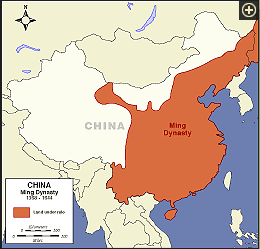Ming Dynasty 1368-1644
Ming Dynasty Jar (1426–1435)
China Porcelain painted in under-glaze blue
 H. 19 in. (48.3 cm)Gift of Robert E. Tod, 1937 (37.191.1) On view: Gallery 204
H. 19 in. (48.3 cm)Gift of Robert E. Tod, 1937 (37.191.1) On view: Gallery 204
Although, this image does not clearly show the Xuande mark and period on the jar, it is widely accepted that these particular markings came from “the famous calligrapher Shendu, since the official mark of Xuande is following his hand writing.”
The Ming Dynasty (1368-1644) restored its Chinese reign and reinstated traditional Chinese art after reclaiming control from a century of being ruled by the Mongols between (1279-1368).
I selected the above jar for its shape and color; the cobalt blue on the white porcelain background is the ideal setting for focusing on the fine intricate lines of the dragon. The following quote sums up the image on the jar, “his dorsal fins are like the teeth of a buzz saw, his claws have a strong bone structure, and he moves around the jar with total power yet consummate grace.”
Dragons are an important symbol of China, contrary to the western folklore who tend to see dragons as fearsome and destructive creatures. In China the dragon is associated with the Emperor’s emblem and the people believe the Dragon is friendly and helpful, it is associated with power, wisdom, strength, goodness, gives blessings and protection, wards off evil spirits, and brings good luck and rain. There seems to be countless meanings for its beloved symbolism in the Chinese culture. For the sake of a shorter blog I have selected the above explanation.
Most Eastern dragons are shown with three to four toes or claws. Only the emperor’s objects or attire had five toed dragons, shown as a symbol of power.
Dragon Jar China
Date: AD 1426-35 (Ming dynasty)
Who do you think possessed this Jar?
 Ok, start counting… this little Dragon went to the market; this little Dragon stayed home; don’t stop counting I know you know this rhyme… 🙂
Ok, start counting… this little Dragon went to the market; this little Dragon stayed home; don’t stop counting I know you know this rhyme… 🙂
“So this beautiful vase was made for the emperor in the Imperial workshops. The fierce yellow dragon rushes through the clouds chasing a flaming pearl. His long body winds the whole way around the jar.”
To learn more about this time period and other Dynasties click on the following clip.
http://www.artsmia.org/art-of-asia/history/video-popup-ming.cfm
Below is a diagram showing a comparison between
the Chinese and Western dragons.
Differences
| Chinese dragons | Western dragons | |
| 1. People’s feeling and ideas about dragons. | People in Chinese think that Chinese dragons are lucky creatures which can bring happiness and power, and even worshiped as gods. | Western dragons are portrayed as evil because they would eat people or destroy villages. So there is much folklore about the fighting between heroes and dragons. But there are still some exceptions. Some of them are wise and would help people when they need advice. |
| 2. Dragons’ legs | Chinese dragons all have four legs. | Some Western Chinese have two legs, but some of them have four legs. |
| 3. Dragons’ wings | Most Chinese dragons don’t have wings. | Western dragons usually have bat-like or bird-like wings. |
| 4. Dragons’ skin | Chinese dragons have scales. | Some western dragons have leather skin, not scales. |
| 5. Dragons and festivals | Chinese dragons often appear in Chinese festivals, celebration and weddings. | As we know, western dragons seldom appear in festivals. |
| 6. Similarity and differences with other dragons which are the same species. | Most Chinese dragons look similar though they have different colors and small parts of body features. | Western dragons look very different from other western dragons. Some look like snakes, when others look like dinosaurs, and even lions. |
Sources:
http://www.metmuseum.org/toah/works-of-art/37.191.1
http://www.britishmuseum.org/explore/highlights/highlight_objects/asia/a/archaistic_jade_ring.aspx
“Jar [China] (37.191.1)”. In Heilbrunn Timeline of Art History. New York: The Metropolitan Museum of Art, 2000–. http://www.metmuseum.org/toah/works-of-art/37.191.1 (October 2006)
http://library.thinkquest.org/07aug/00193/introduction3.html
http://library.thinkquest.org/04oct/01925/Comparing%20dragons.html
http://www.artrealization.com/traditional_chinese_art/landscape_painting/ming/ming.htm
http://pacificasiamuseum.org/rankandstyle/html/pdf/RankandStyle_Section_1.pdf


Pingback: Scholars: oldest Chinese dragon found | Dear Kitty. Some blog